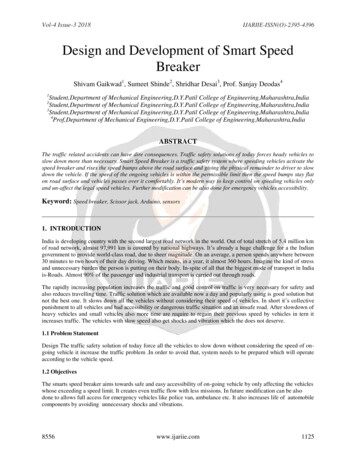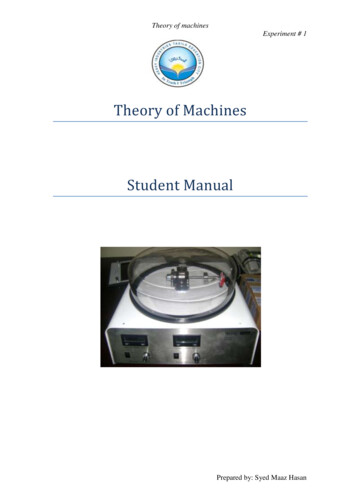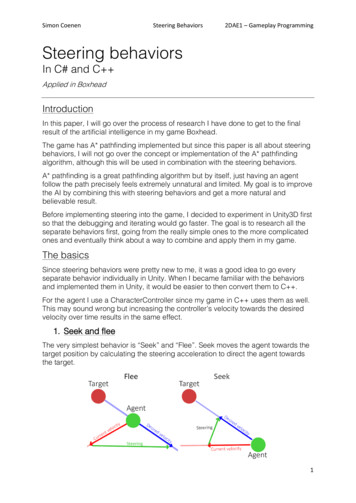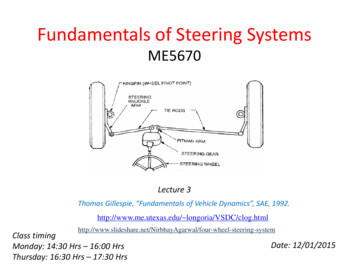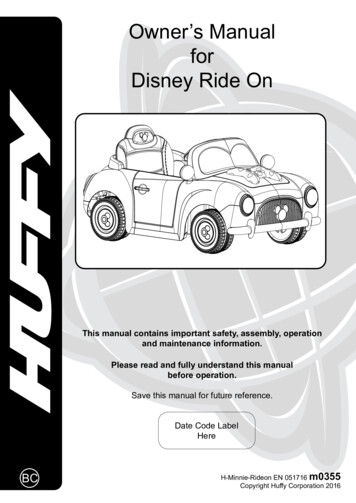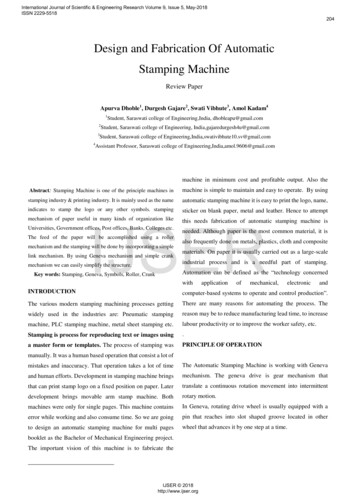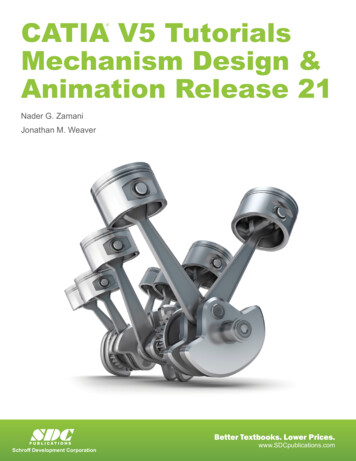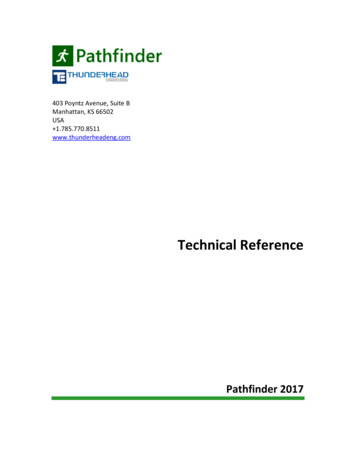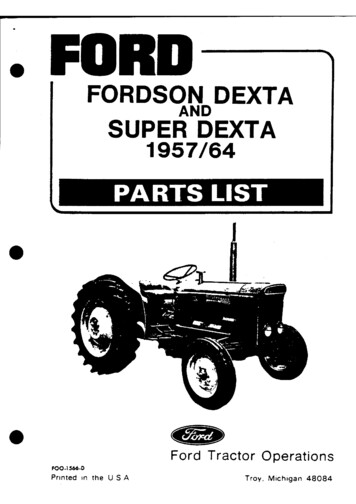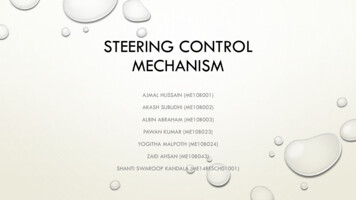
Transcription
STEERING CONTROLMECHANISMAJMAL HUSSAIN (ME10B001)AKASH SUBUDHI (ME10B002)ALBIN ABRAHAM (ME10B003)PAWAN KUMAR (ME10B023)YOGITHA MALPOTH (ME10B024)ZAID AHSAN (ME10B043)SHANTI SWAROOP KANDALA (ME14RESCH01001)
OUTLINE Introduction Types of steering Cad models Role of cornering stiffness Lateral control system Electric power assisted steering Optimization using genetic algorithm Conclusion
INTRODUCTION Collection of components which allows to follow the desired course. In a car : ensure that wheels are pointing in the desired direction of motion. Convert rotary motion of the steering to the angular turn of the wheel. Mechanical advantage is used in this case. The joints and the links should be adjusted with precision. Smallest error can be dangerous Mechanism should not transfer the shocks in the road to the driver's hands. It should minimize the wear on the tyres.
RACK AND PINION STEERING SYSTEM The pinion moves the rack converting circular motion into linear motion along a different axis Rack and pinion gives a good feedback there by imparts a feel to the driving Most commonly used system in automobiles now. Disadvantage of developing wear and there by backlash.
RECIRCULATING BALLUsed in Older automobiles The steering wheel rotates the shaft which turns the worm gear. Worm gear is fixed to the block and this moves the wheels. More mechanical advantage. More strength and durable
POWER STEERING Too much physical exertion was needed for vehicles External power is only used to assist the steering effort. Power steering gives a feedback of forces acting on the front wheel to give a sense of how wheelsare interacting with the road. Hydraulic and electric systems were developed. Also hybrid hydraulic-electric systems were developed. Even if the power fails, driver can steer only it becomes more heavier.
COMPONENTS
ELECTRIC POWER STEERING Uses an electric motor to assist the driving Sensors detect the position of the steering column. An electronic module controls the effort to be applied depending on the conditions. The module can be customised to apply varying amounts of assistance depending on drivingconditions.The assistance can also be tuned depending on vehicle type, driver preferences
HYDRAULIC VS ELECTRIC Electric eliminates the problems of dealing with leakage and disposal of the hydraulic fluid.Another issue is that if the hydraulic system fails, the driver will have to spent more effort since hehas to turn the power assistance system as well as the vehicle using manual effort.Hydraulic pump must be run constantly where as electric power is used accordingly and is moreenergy efficient. Hyrdraulic is more heavy, complicated, less durable and needs more maintenance. Hydraulic takes the power directly from the engine so less mileage.
SPEED SENSITIVE STEERING There is more assistance at lower speeds and less at higher speeds. Diravi is the first commercially available variable power steering system introduced by citroen. A centrifugal regulator driven by the secondary shaft of the gearbox gives a proportionalhydraulic pressure to the speed of the car This pressure acts on a cam directly revolving according to the steering wheel. This gives an artificial steering pressure by trying to turn back the steering to the central position Newer systems control the assistance directly
AUDI R8 Comes in three variants coupe, sport and spyder. Audi r8 is hailed as one of the best road handling cars. Audi r8 beat the porsche 997- considered to be one of the best sports cars ever made in topgear's test.
STEERING CAD MODEL
DYNAMIC ANALYSIStanβf tanβ hf r/ U cosβtanβr tanβ hr r/ U cosβαf τ - βf;αr βr;αf τ - β - hf r/ Uαr - β hr r/ U hr
FINAL EQUATIONS
STATE SPACE EQUATIONS
The matrices of the statespace equations are givenThe elements of thesematrices change due tovariation in C and loadThe new matrices arecalculatedA(1,1) -(Cr Cf)/(m*U);A(2,1) (hr*Cr-hf*Cf)/J;A(1,2) -1 ((hr*Cr-hf*Cf)/(m*(U 2)));A(2,2) -((hr 2)*Cr (hf 2)*Cf)/(J*U);B(1,1) Cf/(m*U);B(2,1) hf*Cf/J;sys ss(A,B,C,D)The transfer functions arethen given by,tf()sysC(1,1) -((Cf Cr)/m) (ls*(hr*Cr-hf*Cf)/J);C(1,2) ((hr*Cr-hf*Cf)/(m*U))-ls*(((hr 2)*Cr (hf 2)*Cf)/(J*U));C(2:3,1:2) eye(2,2);D(1,1) (Cf/m) ls*(hf*Cf/J);sys ss(A,B,C,D);tf(sys)
STABLE AND UNSTABLE REGIONSVARYING CORNERING STIFFNESSStable region
TimeLateral accYaw rateSlip angleM 3000 kgTimeTime
TimeLateral accYaw rateSlip angleM 4000 kgTimeTime
TimeLateral accYaw rateSlip angleM 5000 kgTimeTime
Stiffness(kN/deg)0.350.650.92Settling Time(sec)Peakβ5.81.02Yaw rate3.41.04Lateral acc.10Noovershootβ4.41.04Yaw rate4.31.05Lateral acc.7.191.11β3.51.04Yaw rate4.71.05Lateral acc.6.21.09
Stiffness(kN/deg)1.151.221.25Settling Time(sec)Peakβ3.91.05Yaw rate5.21.05Lateral acc.6.21.11β4.21.06Yaw rate5.71.06Lateral acc.6.81.13β4.31.06Yaw rate5.91.05Lateral acc.6.91.13
LATERAL CONTROL SYSTEM Control strategy: look-down reference system Sensor at the front bumper to measure the lateral displacement GPS to measure the heading orientation Firstly, the road curvature estimator is designed based on the steering angle, which hassteering angle and its derivative as two state variables for which an estimation algorithm isemployed whose input comes from the sensor and the GPS data The closed loop controller is used as a compensator to control the lateral dynamics Precise and real-time estimation of the lateral displacements w. R. T the road areaccomplished using the proposed control system
SINGLE TRACK DYNAMICSActuator Dynamics.X AX BU d sf 0 . a f d sf X , U , A 21 0d ref .sr d a41 sr 10a22 a2100a42 a410 0 ba24 , B 21 01 a44 b410 2 g 4 2 80000A( s) ( s 62.8)(s 12.56 28.77 j )(s 12.56 28.77 j )Feedback Controller Dynamicsa21 lsf g1lsf (lsr g1 g 3 )g1 lsf g 2 lsf (lsf g1 g 3 )g l gg2 , a22 1 sr 2 , a22 Mg 4 I g 4M g 4I g 4M g 4I g 4g1 lsf g 2 lsr (lsf g1 g 3 )l gg l gl (l g g 3 )ga41 2 sr 1 , a42 1 sr 2 sr sr 1, a44 Mg 4 I g 4M g 4I g 4M g 4I g 4 1 lsf ltf 1 l l , b41 c f sr tf b21 c f I I M Mg1 (cr ltr c f ltf ), g 2 (c f cr ), g 3 (cr ltr2 c f ltf2 ), g 4 lsf lsr Structure C f ( s ) Cr ( s )C f (s) K DDf s 2 K Df s K Pf s s 2 2 Ds 1 2 1 1 2 1 K DDr s 2 K Dr s K PrCr ( s ) s s 2 2 Ds 1 2 1 1 2 1 KIs
CONTROL SYSTEMLateral Position Estimation System. X A X B U L( d sr H X ) d sf . d X sf d sr . d sr fU ref 1 1 X l 1 1 Implementation of Control System
RESULTS The lateral displacement result has noovershoot and is well damped.The steering angle and road s.The estimation error of the steering angleis approximately 8% and the curvatureestimation error is around 10%.Simulation result for a speed 80mi/h on dry road (road adhesion factor of 1 )
ELECTRIC POWER ASSISTED STEERING
EQUATIONSSteering column, Driver torqueRoad conditions and friction
Assist Motor ModelRack and Pinion Displacement
CONTROL DIAGRAM
Assist Current (A)Speed 40kmph (without controller)Time
Assist Current (A)Speed 40kmph (with controller)Time
RESULTSSl.NoVehicle SpeedAssist Current(without PID)Assist Current(with 00.380.346900.620.55
Genetic Algorithm
GA QUICK OVERVIEW Developed: USA in the 1970’s Early names: J. Holland, K. Dejong, D. Goldberg Typically applied to: Discrete optimization Attributed features: Not too fast Good heuristic for combinatorial problems Special features: Traditionally emphasizes combining information from good parents(crossover) Many variants, e.g., Reproduction models, operators
SIMPLE GENETIC ALGORITHMproduce an initial population of individualsevaluate the fitness of all individualswhile termination condition not met doselect fitter individuals for reproductionrecombine between individualsmutate individualsevaluate the fitness of the modified individualsgenerate a new populationEnd while
1-POINT CROSSOVER Choose a random point on the two parents Split parents at this crossover point Create children by exchanging tails Pc typically in range (0.6, 0.9)
MUTATION Alter each gene independently with a probability pm Pm is called the mutation rate Typically between 1/pop size and 1/ chromosome length
RESULTS
STABILITY ANALYSIS The vehicle model used in the analysis is a simple three degree of freedomyaw plane representation with differential braking𝑚𝑈𝑥 𝐹𝑥𝑟 𝐹𝑥𝑓 cos𝜆 𝐹𝑦𝑓 sin𝜆 𝑚𝑟𝑈𝑦𝑚𝑈𝑦 𝐹𝑦𝑟 𝐹𝑥𝑓 sin𝜆 𝐹𝑦𝑓 cos𝜆 𝑚𝑟𝑈𝑥𝑑2𝐼𝑧 𝑟 𝑎𝐹𝑥𝑓 sin𝛿 𝑎𝐹𝑦𝑓 cos𝛿 𝑏𝐹𝑦𝑟 (𝛥𝐹𝑥𝑟 𝛥𝐹𝑥𝑓 cos𝜆)
VEHICLE MODEL𝐹𝑥𝑓 𝐹𝑥𝑟𝑓 𝐹𝑥𝑙𝑓𝐹𝑥𝑟 𝐹𝑥𝑟𝑟 𝐹𝑥𝑙𝑟𝛥𝐹𝑥𝑓 𝐹𝑥𝑟𝑓 𝐹𝑥𝑙𝑓𝛥𝐹𝑥𝑟 𝐹𝑥𝑟𝑟 𝐹𝑥𝑙𝑟
EQUATIONS INVOLVED Assuming small angles and equal slip angles on the left and right wheels,𝛼𝑓𝑟 𝑈𝑦 𝑟𝑎𝑈𝑥 𝛿𝑈𝑦 𝑟𝑏𝛼𝑟 𝑈𝑥 Using a linear tire model, the lateral forces are given as𝐹𝑦𝑓 𝐶𝑓 𝛼𝑓𝐹𝑦𝑟 𝐶𝑟 𝛼𝑟
EQUATIONS INVOLVED Where Cf and Cr are the front and rear cornering stiffness's, respectively. Substituting theexpressions or the lateral forces into equations 1 through 3 and making small angleapproximations yields, 𝑚𝑈𝑥 𝑚𝑟𝑈𝑦 𝐹𝑥𝑟 𝐹𝑥𝑓 𝐶𝑓 𝑚𝑈𝑦 𝐶𝑟(𝑈𝑦 𝑟𝑏)𝑈𝑥 𝐼𝑧 𝑟 𝑎𝐹𝑥𝑓 𝛿 𝑎𝐶𝑓 𝐶𝑓(𝑈𝑦 𝑟𝑎)(𝑈𝑦 𝑟𝑎)𝑈𝑥𝑈𝑥(𝑈𝑦 𝑟𝑎)𝑈𝑥𝛿 𝑚𝑟𝑈𝑥 𝐶𝑓 𝛿 𝐹𝑥𝑓 𝛿 𝑏𝐶𝑟(𝑈𝑦 𝑟𝑏)𝑈𝑥𝑑2 𝑎𝐶𝑓 𝛿 (𝛥𝐹𝑥𝑟 𝛥𝐹𝑥𝑓 )
EQUATIONS INVOLVED The linearization of a vehicle about a constant longitudinal velocity gives,.where . x A x x e e 100 0 (Cf Cr ) (Cf Cr ) ( aCf bCr ) 0 mSmmS A 0001 22( aCf bCr)(aCf bCr) (aCf bCr) 0 IzSIzIzS
STABILITY ANALYSIS Taking the determinant of I A yields the characteristic equation of the system 2 2 a1 a2 0a1 a2 (C f Cr ) I z (a 2 C f b 2 C r )mI z mSC f Cr (a b) 2 (bC r aC f )mS 2I z mS 2
STABLE AND UNSTABLE REGIONSVARYING CORNERING STIFFNESSStable oversteer regionStable understeer region
LINEARIZATION WITHOUT VIRTUAL FORCE In an oversteering case (aCf bCr), the coefficient a2 will be negative when thespeed The critical speed obtainedS C f C r ( a b) 2(aC f bC r )m
SPEED SENSITIVE STEERING There is more assistance at lower speeds and less at higher speeds. Diravi is the first commercially available variable power steering system introduced by citroen. A centrifugal regulator driven by the secondary shaft of the gearbox gives a proportional hydraulic pressure to the speed of
